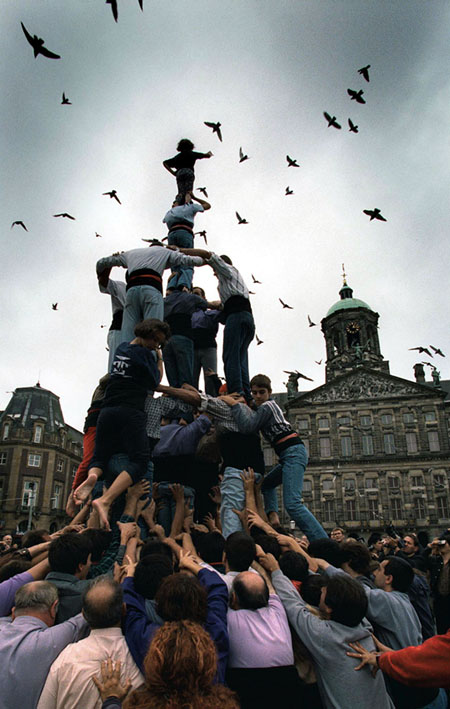Amsterdam , 1997
WALKING MONUMENT
Performance involving 300 people as a living monument for 2 and a half minutes. First Prize Prix de Rome Art and Public Space 1997.
DAM SQUARE, AMSTERDAM, 8 SEPTEMBER 1997, 1:15 PM. An ordinary scene: mostly tourists occupy the square. Business as usual. Except… there are no people sitting on the steps of the National Monument, as it has been temporarily removed for restoration. A huge scaffolding takes its place. Everything seems normal until 112 people join hands to create a circle. Then another 25 men climb on their shoulders. They form the foundations of a human tower. After several ‘storeys’, finally, at the apex, a little girl tops it with her hand up in the air. The tower, swaying alarmingly, reaches a final height of 11 metres and consists of 160 people. These ‘castle-builders’ from Spain, the Castellers, were honouring a tradition that dates back to 16th-century Tarragona.
The intention was to give Amsterdam a ‘walking monument’ as a replacement for the National Monument; the most controversial monument in Amsterdam. It became a particular bone of contention during the 1960s, when it was invaded by hordes of ‘Dam sleepers’: hippies regarded by the citizenry as ‘unwashed, disease-spreading’ vagrants. Nowadays it has acquired something of a sacred status. It plays a central role in Remembrance Day ceremonies. Architect J.J.P. Oud and sculptor J. Raedecker, who designed it as a memorial to those who died during the Second World War, wanted it to be accessible to the public, part of everyday urban life. They stressed it should not only deal with death, but primarily with life. Framis intended the W alking Monument in the spirit of Oud and Raedecker: as a living, breathing – and breathtaking – monument, a metaphor for life, a place of memory. The material of the monument is of the same substance as the viewers, who can directly communicate with the monument.
Dam Square, Amsterdam, 2 May 2003. Business as usual. Tourists on their way to Madame Tussaud’s or just hanging out and feeding the pigeons. The National Monument has been painstakingly restored and is back in its proper place now. The steps at the base are being used as a meeting point and resting spot once again. Nothing special will happen at 1:15 p.m. The Castellers are in Spain and Alicia Framis is working on other projects. But does the W alking Monument still exist?
Yes, it does, and on two separate levels. It exists in the heads of all those people who happened to be there. Few tourists will ever have talked about the National Monument when they return home after their trip to Amsterdam, but some will have mentioned the W alking M onument. Probably neither as a monument nor as a work of art, but as an event to enjoy with enough impact to remember. Furthermore, it does exist in the discussion on the ephemeral position, as temporary art projects can be taken out of the traditional art context.

DAM SQUARE, AMSTERDAM, 8 SEPTEMBER 1997, 1:15 PM. An ordinary scene: mostly tourists occupy the square. Business as usual. Except… there are no people sitting on the steps of the National Monument, as it has been temporarily removed for restoration. A huge scaffolding takes its place. Everything seems normal until 112 people join hands to create a circle. Then another 25 men climb on their shoulders. They form the foundations of a human tower. After several ‘storeys’, finally, at the apex, a little girl tops it with her hand up in the air. The tower, swaying alarmingly, reaches a final height of 11 metres and consists of 160 people. These ‘castle-builders’ from Spain, the Castellers, were honouring a tradition that dates back to 16th-century Tarragona.
The intention was to give Amsterdam a ‘walking monument’ as a replacement for the National Monument; the most controversial monument in Amsterdam. It became a particular bone of contention during the 1960s, when it was invaded by hordes of ‘Dam sleepers’: hippies regarded by the citizenry as ‘unwashed, disease-spreading’ vagrants. Nowadays it has acquired something of a sacred status. It plays a central role in Remembrance Day ceremonies. Architect J.J.P. Oud and sculptor J. Raedecker, who designed it as a memorial to those who died during the Second World War, wanted it to be accessible to the public, part of everyday urban life. They stressed it should not only deal with death, but primarily with life. Framis intended the W alking Monument in the spirit of Oud and Raedecker: as a living, breathing – and breathtaking – monument, a metaphor for life, a place of memory. The material of the monument is of the same substance as the viewers, who can directly communicate with the monument.
Dam Square, Amsterdam, 2 May 2003. Business as usual. Tourists on their way to Madame Tussaud’s or just hanging out and feeding the pigeons. The National Monument has been painstakingly restored and is back in its proper place now. The steps at the base are being used as a meeting point and resting spot once again. Nothing special will happen at 1:15 p.m. The Castellers are in Spain and Alicia Framis is working on other projects. But does the W alking Monument still exist?
Yes, it does, and on two separate levels. It exists in the heads of all those people who happened to be there. Few tourists will ever have talked about the National Monument when they return home after their trip to Amsterdam, but some will have mentioned the W alking M onument. Probably neither as a monument nor as a work of art, but as an event to enjoy with enough impact to remember. Furthermore, it does exist in the discussion on the ephemeral position, as temporary art projects can be taken out of the traditional art context.